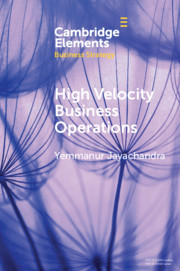Element contents
High Velocity Business Operations
Published online by Cambridge University Press: 15 July 2020
Summary
Keywords
- Type
- Element
- Information
- Series: Elements in Business StrategyOnline ISBN: 9781108867801Publisher: Cambridge University PressPrint publication: 13 August 2020
References
- 13
- Cited by

